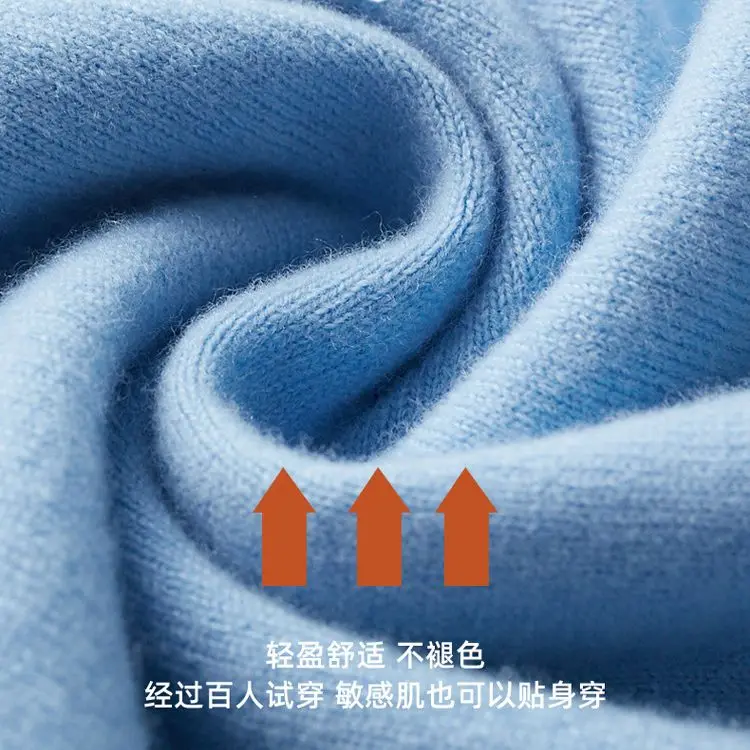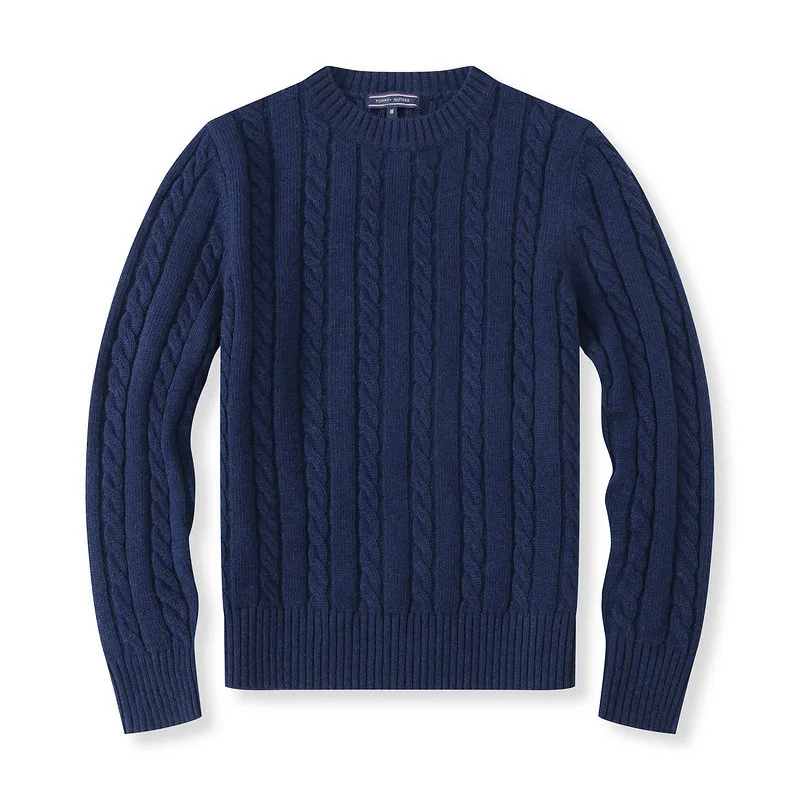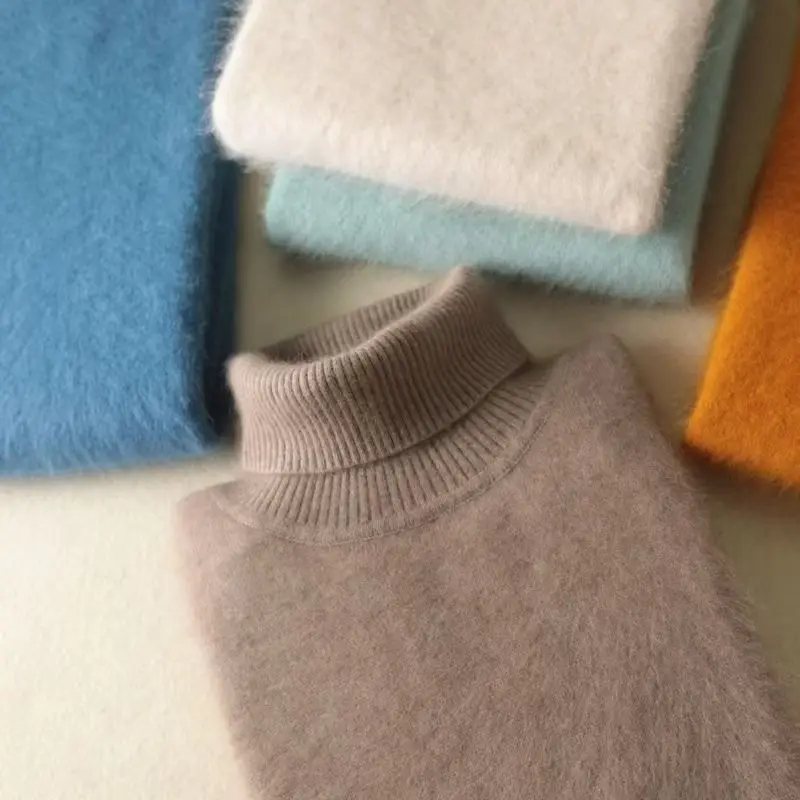The Unmistakable Feel of Premium Cashmere
When it comes to luxury fabrics, few can rival the distinctive touch of genuine cashmere. The feel of this exquisite material against your skin is often the first and most telling indicator of its quality. While modern technology has given us many ways to assess textiles, the age-old method of tactile evaluation remains the most immediate and reliable approach to distinguishing premium cashmere from inferior alternatives.
What makes cashmere’s touch so special? It’s a unique combination of exceptional softness, surprising warmth despite its lightweight nature, and a gentle embrace that feels almost like a second skin. This distinctive feel has made cashmere treasured throughout history, sought after by those who appreciate true luxury.
In today’s market, however, identifying authentic quality cashmere has become increasingly challenging. With varying grades, blends, and manufacturing techniques all claiming to be “pure cashmere,” consumers often find themselves unsure of what genuine cashmere should actually feel like.
This guide aims to equip you with expert knowledge on how to assess cashmere through touch. By understanding the styling tips for cashmere cardigans and other garments, you’ll gain confidence in evaluating this luxurious material and making informed purchasing decisions based on tactile qualities that simply cannot be faked.
The Signature Tactile Properties of Genuine Cashmere
Exceptional Softness and Smoothness
The most immediately noticeable characteristic of authentic cashmere is its extraordinary softness. When you touch high-quality cashmere, your fingers experience a sensation often described as “buttery” or “silky” – a smoothness that feels natural rather than artificially created. This softness isn’t just surface-level; it permeates the entire garment.
Unlike chemically treated materials that might initially feel soft but change with washing, genuine cashmere maintains its softness throughout its lifetime. The touch rivals other naturally soft textures – smoother than fine cotton, more delicate than silk, and remarkably gentle even against the most sensitive skin areas like the neck or inner wrists. Many brushed cashmere sweaters showcase this exceptional softness to perfection, creating an even more heightened tactile experience.
Lightweight Yet Remarkably Warm
One of the most surprising aspects of authentic cashmere is its paradoxical nature – it feels incredibly lightweight in your hands yet provides exceptional warmth. This unique combination creates a distinctive airy feel while delivering impressive insulation. When you hold quality cashmere, it shouldn’t feel heavy or dense despite its warming properties.
This remarkable weight-to-warmth ratio is a key indicator of quality cashmere. Scientifically speaking, cashmere fibers provide 3-8 times more insulation than regular sheep’s wool while weighing significantly less. When assessing a cashmere garment, this lightweight warmth should be immediately apparent – the fabric should feel substantial enough to provide comfort but never bulky or weighty.
Non-Itchy Comfort Against Skin
Premium cashmere is completely free of the scratchiness or prickliness often associated with wool. This complete absence of itch factor is why even people with wool sensitivities can comfortably wear pure cashmere directly against their skin. When you touch genuine cashmere to your neck or face, you should experience only smooth comfort without any irritation or desire to scratch.
This non-itchy quality distinguishes true cashmere from lower-quality fibers and blends. The sensation against bare skin should be consistently comfortable, allowing the material to be worn for extended periods without any discomfort. Understanding how to properly judge cashmere quality by touch helps ensure you select pieces that offer this characteristic comfort.
The Subtle “Bloom” or Halo Effect
Quality cashmere has a delicate, slightly fuzzy surface that creates what experts call a “bloom” or “halo” effect. This subtle fuzziness can be both seen and felt when you gently run your fingers across the surface. It’s not pronounced fluffiness but rather a soft dimension that gives the fabric a gentle depth.
This bloom indicates the presence of fine fibers rather than coarse ones. You can identify this characteristic by lightly brushing your fingers across the fabric’s surface – authentic cashmere will have a consistent, subtle halo that feels natural rather than artificially created. This bloom differs from the artificial fluffing treatments sometimes used on inferior products, which typically feel too uniform or disappear after washing.
Luxurious Drape and Movement
Premium cashmere exhibits exceptional drape and movement that’s immediately apparent when you handle the fabric. It should flow and fall naturally, molding gently to the body rather than standing stiffly. This fluid quality creates an elegant silhouette that moves gracefully with the wearer.
When you pick up a cashmere garment and let it hang, it should cascade softly rather than remaining rigid. The fabric should feel like it has the perfect balance between structure and flexibility – substantial enough to hold its shape yet supple enough to move naturally. This luxurious drape distinguishes true cashmere from inferior fabrics that lack this graceful flow.
The Science Behind Cashmere’s Distinctive Feel

Fiber Diameter: The Micron Measurement
The extraordinary softness of premium cashmere comes down to science – specifically, the diameter of individual fibers measured in microns. The finest cashmere fibers measure between 14-16 microns in thickness, with Grade A cashmere strictly limited to fibers under 16 microns. To put this in perspective, a human hair averages around 70 microns, and even fine merino wool typically measures 18-24 microns.
This extraordinary fineness directly translates to the softness you feel. Each micron difference significantly impacts the tactile experience – even the difference between 15 and 17 microns is noticeable to a discerning touch. This microscopic thinness explains why cashmere feels dramatically softer than other natural fibers. Learning how to choose high-quality cashmere often starts with understanding these crucial measurements.
Natural Crimp and Fiber Structure
Beyond their fineness, cashmere fibers possess a natural waviness or crimp that contributes significantly to their distinctive feel. This natural undulation creates tiny air pockets throughout the fabric, providing exceptional insulation while maintaining breathability. When you touch cashmere and feel its springy resilience, you’re experiencing this crimp in action.
The unique protein structure of cashmere fibers allows them to bend up to 20,000 times without breaking, compared to about 3,000 times for wool. This molecular arrangement creates the characteristic “bounce back” quality that makes cashmere feel resilient yet soft. The natural crimp is also responsible for cashmere’s lightweight warmth – those microscopic air pockets trap body heat while allowing moisture to escape, creating the perfect balance of insulation and comfort.
Staple Length and Durability
The length of individual cashmere fibers (known as staple length) significantly impacts how the fabric feels and performs. Premium cashmere features longer fibers, typically exceeding 35mm in length. These longer fibers create a smoother, more durable fabric that maintains its luxurious feel through years of wear.
When you touch high-quality cashmere and notice its smooth consistency and resistance to pilling, you’re experiencing the benefits of long staple fibers. Shorter fibers, by contrast, tend to work their way out of the yarn over time, creating a rougher texture and the characteristic pilling that diminishes quality. The finest cashmere sweaters utilize these long fibers to create garments with lasting tactile appeal and exceptional durability.
Hands-On: The Expert Tactile Assessment Guide
The Sensitive Skin Test
One of the most revealing ways to assess cashmere quality is by testing it against sensitive skin areas. Gently press the fabric against your inner wrist, neck, or even your cheek – areas where skin is thinner and more sensitive to texture. Authentic cashmere should feel consistently smooth and comfortable against these areas without any prickling or irritation.
During this test, pay attention to your immediate sensory response. Premium cashmere will feel like a gentle caress, while inferior products might trigger slight discomfort or a desire to scratch. This reaction is often subtle but revealing – even minor irritation suggests the presence of coarser fibers or non-cashmere content. This technique is especially valuable when styling cashmere cardigans for versatile looks as it helps ensure day-long comfort.
The Pinch and Release Test
To assess cashmere’s resilience and elasticity, perform the pinch and release test. Gently pinch a small section of the fabric between your thumb and forefinger, hold for a few seconds, then release. High-quality cashmere will quickly spring back to its original form with minimal wrinkling or compression marks.
This recovery ability indicates excellent fiber quality and proper construction. Premium cashmere should bounce back almost immediately, showing its natural resilience. If the fabric remains creased or takes a long time to recover, it suggests inferior fibers or poor manufacturing. This test reveals the natural springiness created by the fiber’s crimp structure and is a reliable indicator of how the garment will maintain its shape with wear.
Evaluating Density and Weight
Quality cashmere strikes a perfect balance between substance and lightness. When assessing a garment, hold it in your hands and feel its weight distribution. It should feel substantial enough to provide warmth but never heavy or bulky. The weight should be evenly distributed throughout the garment without thin or excessively dense areas.
Pay attention to how the fabric feels between your fingers when gently compressed. Premium cashmere has enough density to provide structure while maintaining its characteristic lightness. If a garment feels too thin or flimsy, it may contain inferior fibers or insufficient material. Conversely, if it feels unusually heavy, it might include non-cashmere fibers or excess treatments that compromise its natural properties.
Checking for Texture Uniformity
Run your hands systematically across the entire garment to detect any inconsistencies in texture or construction. High-quality cashmere should feel uniform throughout, without lumps, thin spots, or irregular areas. The texture should be consistently smooth and even across the entire piece.
Pay particular attention to seams and edges where manufacturing shortcuts often become apparent. Premium cashmere should maintain its consistent feel even in these areas. Any abrupt changes in texture, unexpected roughness, or uneven thickness likely indicate poor manufacturing or fiber blending. This uniformity test reveals much about the overall quality of both the raw materials and the construction process.
Red Flags: How Inferior Cashmere Feels to Touch

Scratchy or Coarse Texture
Perhaps the most obvious sign of inferior cashmere is a scratchy or coarse texture. When you run your fingers across the fabric, any prickliness or roughness should immediately raise concerns. True cashmere should never feel scratchy against your skin.
This unpleasant texture typically indicates lower-grade fibers, the inclusion of guard hairs (coarser outer hairs that should be removed during processing), or the addition of non-cashmere content. The discomfort becomes even more apparent when the material is placed against sensitive skin areas. Many customers find that men’s V-neck cashmere sweaters made with premium fibers showcase the smooth, non-scratchy texture that quality cashmere should possess.
Stiff or Rigid Hand-Feel
Quality cashmere should never feel stiff or rigid. If the fabric lacks suppleness when you handle it or doesn’t flow naturally when draped, it likely indicates poor processing or inferior fiber quality. Premium cashmere has an inherent fluidity that allows it to move gracefully.
This stiffness often feels almost cardboard-like or unnaturally structured – a stark contrast to genuine cashmere’s soft pliability. Such rigidity typically results from manufacturing shortcuts, excessive chemical processing, or the inclusion of synthetic fibers. When you handle the material, it should yield gently to your touch rather than feeling inflexible or unyielding.
Artificially Slick or Overly Smooth Surface
Be wary of cashmere that feels unnaturally slick or has a surface that seems too perfectly smooth. Some manufacturers apply silicone-based treatments to create artificial softness that masks poor-quality fibers. This synthetic smoothness lacks the natural character and depth of genuine cashmere.
Authentic cashmere has a natural softness with subtle texture variations that reflect its organic origins. The artificially treated surface often has an almost plastic-like perfection that feels suspiciously uniform. While initially appealing, this artificial treatment typically washes out after a few cleanings, revealing the true inferior quality beneath.
Inconsistent Thickness or Density
Poor-quality cashmere often reveals itself through uneven thickness or density. When you run your hands across the fabric, you might notice lumpy areas, unexpected thin spots, or variations in weight that shouldn’t exist in premium cashmere. High-quality cashmere maintains consistent thickness throughout.
These inconsistencies typically result from inferior manufacturing processes, uneven yarn tension during production, or variations in fiber quality. The result is a fabric that feels noticeably different depending on which area you touch – a clear indication of poor quality control and construction standards.
Greasy or Waxy Residue
Another telltale sign of inferior cashmere is a subtle greasy or waxy sensation left on your fingers after touching the fabric. Premium cashmere should feel clean to the touch without any residue or coating.
This unpleasant residue typically indicates the presence of chemical treatments used to artificially enhance the material’s appearance or feel. These treatments can include silicone softeners, stiffening agents, or other finishing chemicals that attempt to mask poor fiber quality. Not only does this affect the tactile experience, but these chemicals often wash out quickly, dramatically changing how the garment feels after cleaning.
Comparative Touch: Cashmere vs. Other Fine Fibers
Cashmere vs. Merino Wool
While both cashmere and fine merino wool are premium natural fibers, their tactile differences become apparent through direct comparison. Cashmere feels noticeably softer and lighter than even the finest merino, with a silkier hand that’s immediately distinguishable.
When touching these materials side by side, you’ll notice cashmere has a more delicate touch and creates less friction against the skin. Merino offers excellent softness for wool but still retains a slightly more substantial feel and minimal crimp that’s perceptible to discerning fingers. Perhaps most distinctively, cashmere provides significantly more warmth despite feeling lighter – a paradoxical quality that merino cannot match. The collection of cashmere turtlenecks exemplifies these distinctive properties that set cashmere apart from other fine wools.
Cashmere Wrap Sweaters, Women's Cashmere Pullovers
$75.89 Select options This product has multiple variants. The options may be chosen on the product pageCashmere Cable Knit Sweaters, Women's Cashmere Pullovers
Price range: $111.82 through $112.93 Select options This product has multiple variants. The options may be chosen on the product pageCropped Cashmere Sweaters, Women's Cashmere Pullovers
$155.77 Select options This product has multiple variants. The options may be chosen on the product pageOversized Cashmere Sweaters, Plus Size Cashmere Sweaters, Women's V-Neck Cashmere Sweaters
$136.87 Select options This product has multiple variants. The options may be chosen on the product page- Price range: $108.11 through $130.03 Select options This product has multiple variants. The options may be chosen on the product page
Striped Cashmere Sweaters, Women's Cashmere Pullovers
$139.68 Select options This product has multiple variants. The options may be chosen on the product page
Cashmere vs. Regular Wool
The difference between cashmere and standard sheep’s wool is dramatic and immediately apparent through touch. Regular wool typically feels much coarser, with a characteristic scratchiness that contrasts sharply with cashmere’s smooth embrace. This distinction becomes particularly noticeable when placing either fabric against sensitive skin.
Beyond texture, standard wool feels significantly heavier than cashmere while providing less warmth. The weight-to-warmth ratio differs dramatically – cashmere can be up to eight times warmer than regular wool while feeling much lighter. This difference stems from the fiber diameter disparity, with standard wool fibers typically measuring 20-40 microns compared to cashmere’s 14-16 microns. This scientific difference translates to a tactile experience that’s unmistakably distinct.
Cashmere vs. Synthetic Blends
Distinguishing between pure cashmere and synthetic or semi-synthetic blends becomes straightforward once you’re familiar with cashmere’s distinctive properties. Synthetic fibers typically lack cashmere’s breathability, creating a slight “plastic” quality that becomes apparent with extended touching.
While blends may initially mimic some of cashmere’s softness, they cannot replicate its unique combination of lightweight warmth and natural resilience. Synthetics often feel slightly slick or artificially uniform, missing the subtle depth and character of pure cashmere. Perhaps most tellingly, synthetic content often creates a slight static charge or clinging sensation that’s absent in natural cashmere. When worn, the difference becomes even more pronounced as synthetics don’t regulate temperature or moisture in the same way pure cashmere does.
Beyond Touch: Supporting Indicators of Cashmere Quality

Visual Texture Assessment
While touch remains the primary assessment method, visual cues can confirm what your fingers tell you about cashmere quality. Premium cashmere has a subtle, even knit with a gentle sheen that’s noticeable but never shiny or glossy. The surface should appear uniform but not artificially perfect.
Watch for warning signs like excessive shininess (suggesting artificial treatments), obvious pilling even before wear (indicating short fibers), or irregular stitching (revealing poor construction). Quality cashmere has a visual depth that comes from the natural variation in its fibers – a subtle richness rather than a flat appearance. Many customers wonder if cashmere cardigans are worth the investment, and these visual indicators can help confirm the quality that justifies their price.
Resilience and Recovery Observation
Quality cashmere demonstrates exceptional resilience that can be observed as well as felt. When a cashmere garment is folded or gently stretched, it should recover its original shape quickly and completely. This visual recovery complements the tactile bounce-back you feel during the pinch test.
Watch how the fabric behaves when manipulated – premium cashmere returns gracefully to its original state without remaining creased or deformed. This recovery indicates excellent fiber quality and proper construction techniques. Poor-quality cashmere, by contrast, often shows persistent wrinkles or distortion after being folded or stretched – a visible indication of inferior fibers or manufacturing.
Price as a Quality Indicator
While price alone doesn’t guarantee quality, it does provide important context for your tactile assessment. The production of genuine, high-grade cashmere involves significant costs – from the careful collection of undercoat fibers to the specialized processing required for premium results. These production realities mean authentically fine cashmere simply cannot be inexpensive.
Suspiciously low prices should prompt especially careful tactile scrutiny. While premium cashmere represents an investment, its exceptional durability and timeless appeal typically provide excellent value over time. The tactile qualities described throughout this guide generally correlate with price points reflecting the true cost of quality production. Collection pieces like men’s cashmere pullovers demonstrate the quality differences that justify their higher price points compared to lower-priced alternatives.
Preserving the Luxurious Feel: Essential Care Practices
Maintaining cashmere’s exceptional feel requires appropriate care practices that preserve its natural properties. Gentle washing using cold water and specialized cashmere detergent helps maintain the fiber structure that creates its distinctive touch. Always hand wash or use your machine’s delicate cycle, and never wring or twist the wet fabric.
Drying techniques significantly impact tactile quality – lay cashmere flat on a towel away from direct heat or sunlight to maintain its shape and prevent shrinkage. When storing cashmere, fold rather than hang to prevent stretching, and use breathable containers with cedar elements to deter moths naturally.
Light pilling is normal even with quality cashmere, but it should be addressed properly to maintain tactile excellence. Use a cashmere comb or specialized de-pilling tool with gentle, directional strokes rather than pulling or cutting. These care practices ensure that the exceptional feel that attracted you to cashmere in the first place remains consistent throughout the garment’s long life.
Can You Train Your Hands to Recognize Quality Cashmere?
Developing sensitivity to cashmere quality is a skill that improves with deliberate practice. You can train your tactile perception by creating opportunities for comparative touching – visiting luxury retailers to handle different grades of cashmere side by side helps establish reference points for what exceptional quality feels like.
Start by building a tactile memory for authentic cashmere by repeatedly handling known high-quality pieces. Pay attention to the specific sensations described throughout this guide – the weightless warmth, the incomparable softness, the gentle resilience. Over time, your fingers will become increasingly sensitive to quality variations.
This tactile education becomes progressively more refined as you experience more examples. Consider keeping a small swatch of premium cashmere as a reference point when shopping. With practice, you’ll develop an almost intuitive ability to immediately recognize authentic quality cashmere simply by touch.
Is That Amazing Deal Really Pure Cashmere? Trust Your Fingertips
In a market where labels and descriptions can sometimes be misleading, your hands remain the most reliable tool for assessing cashmere quality. The tactile properties described throughout this guide – exceptional softness, lightweight warmth, non-itchy comfort, subtle bloom, and luxurious drape – simply cannot be faked or artificially replicated in a way that withstands careful assessment.
When encountering suspiciously affordable “cashmere” or claims of rare bargains, let your fingertips be your guide. The science behind cashmere’s distinctive feel stems from its natural fiber structure, which either exists or doesn’t. No amount of treatment or processing can truly replicate these inherent properties in inferior materials.
By applying the tactile assessment techniques you’ve learned – from the sensitive skin test to evaluating density and checking for texture uniformity – you can make confident, informed decisions regardless of marketing claims or price tags. Trust what your hands tell you, and you’ll never be disappointed in your cashmere investments.







